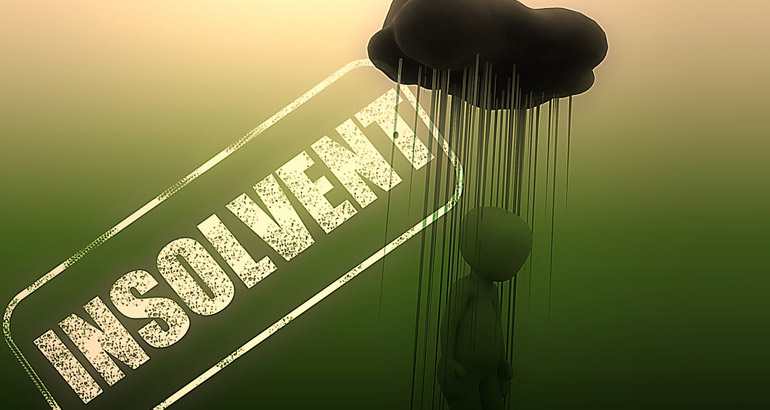5 Easy Facts About Insolvency Practitioner Shown
Wiki Article
7 Easy Facts About Insolvency Practitioner Described
Table of ContentsInsolvency Practitioner - An OverviewExamine This Report about Insolvency Practitioner10 Simple Techniques For Insolvency PractitionerThe Main Principles Of Insolvency Practitioner Our Insolvency Practitioner PDFsLittle Known Facts About Insolvency Practitioner.About Insolvency Practitioner
Bankruptcy is when obligations are more than the value of the firm, or when a debtor can not pay the financial obligations they owe. A company can end up being insolvent due to a variety of situations that cause poor capital. When confronted with insolvency, a company or person can get in touch with lenders directly and restructure financial obligations to pay them off.Insolvency can bring about insolvency procedures, in which lawsuit will certainly be taken versus the insolvent individual or entity, and properties may be liquidated to pay off arrearages. Company owner might get in touch with lenders directly and restructure financial debts into even more convenient installments. Creditors are normally amenable to this strategy because they intend to be paid off and prevent losses, also if the payment is on a postponed schedule.
Getting The Insolvency Practitioner To Work
The proprietor creates a proposal outlining exactly how the financial obligation might be reorganized using cost reductions or other strategies for assistance. The proposal shows lenders how the service might generate enough cash money circulation for profitable operations while paying its financial debts. Commonly, a forgiven debt may be considered income by the Irs (INTERNAL REVENUE SERVICE).
Insolvency Practitioner for Beginners
Business might finish up paying huge amounts of money in damages and be overcome procedures. When procedures cease, so does the company's revenue. Absence of income leads to unpaid expenses and lenders requesting cash owed to them. Some companies come to be bankrupt since their products or solutions don't develop to fit consumers' transforming needs.Expenditures exceed profits and costs stay unpaid. Sorts of bankruptcy consist of cash-flow bankruptcy and balance-sheet insolvency. Cash-flow bankruptcy occurs when a firm has the possessions to cover their debts but they remain in the wrong type, such as property rather than liquid funds. Balance-sheet insolvency, on the other hand, shows an absence of properties in any kind of form to cover debts.
The internal revenue service states that a person is financially troubled when the total responsibilities go beyond complete possessions. A insolvency, on the various other hand, is a real court order that depicts how a financially troubled individual or service will settle their financial institutions, or exactly how they will certainly sell their assets in order to make the settlements.
Insolvency Practitioner - The Facts

Financial obligation combination is when you incorporate multiple lendings into one new financing, often to attain better terms. Bankruptcy is not the same as personal bankruptcy, although a company that has come to be insolvent might apply for insolvency. Bankruptcy is the state of not having the ability to pay your responsibilities while bankruptcy is a legal process to discharge your financial debts.
Comprehending the aspects that can cause insolvency, such as overspending, can aid you stop insolvency and its repercussions.
4 Easy Facts About Insolvency Practitioner Described
It is well recognized that directors and officers of companies (and supervisors of limited liability business) owe fiduciary duties to their companies and their investors (or participants). These fiduciary responsibilities are defined by state statutes and, though there are variations from one state to another, they usually consist of a task of loyalty and a duty of care.
The task of treatment calls for directors and police officers to work out diligence, to make enlightened choices, and to act in good faith to make sure that their actions remain in the most effective interest of the business. Though past the range of this discussion, some states enable these responsibilities to be limited either by so noting in the organizational papers or abiding with various other needs.
Not known Factual Statements About Insolvency Practitioner
Many states define bankruptcy in two ways( 1) when a firm's liabilities become higher than the amount of its properties or (2) when the business becomes unable to pay its financial obligations as they become dueand embrace both interpretations (Insolvency Practitioner). The change in obligations happens because when a firm is bankrupt, there is no value in the company past that owed to the business's lenders so that the equity holders no much longer have an economic risk in the firmBe careful about giving shareholders preferential treatment at the expense of creditors (e.g., authorizing and funding a dividend or a stock redemption). Take care about favoritism in between courses of investors. Clear up efforts to discover all the realities prior to taking a details program of activity; supervisors must really believe that any type of decisions made are in the very best passions redirected here of the corporation in its whole (i.e., decisions will certainly be assessed in knowledge in light of the effect of such actions on the firm).
In any type of bankruptcy or bankruptcy proceeding, payments made to particular financial institutions at the cost of other financial institutions can be clawed back, specifically if there is some connection between the firm and the financial institution. Think about suggesting at a yearly shareholder conference (or any type of various other conference of shareholders) a resolution attesting that all previous business choices and activities taken by the directors and officers of the corporation were taken in great confidence after a workout of practical treatment.
The Definitive Guide to Insolvency Practitioner
Completely reveal any type of personal or service partnerships with parties on the other side of transactions involving the company to stay pop over to this site clear of the appearance of a dispute of passion. In assessing potential fund increasing purchases or a sale of possessions of find out the distressed firm, realize that these deals might be looked at later in light of any kind of succeeding development of supervisors' fiduciary tasks to include financial institutions.Report this wiki page